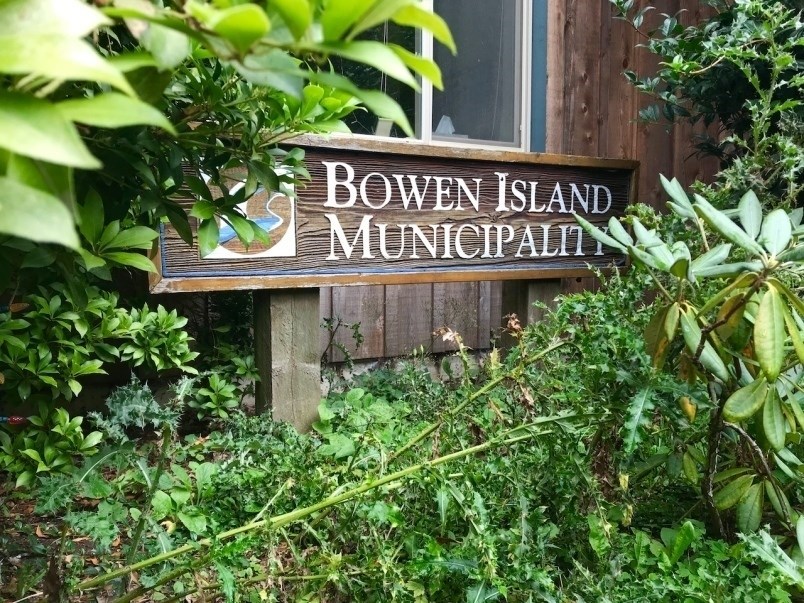A number of Bowen Islanders are asking Bowen Island Municipality to rethink parts of its Land Use Bylaw amendment, which came up for a public hearing Monday afternoon.
The scope of what’s been termed a “housekeeping bylaw,” (though the branding’s since changed) is to amend the LUB to “streamline and clarify” the document “while not changing permitted uses on properties on Bowen,” according to an October staff report. It’s the first substantial review of the document since adoption in 2002. Amendments range from changing building calculations (grade, lot coverage and so on), to deleting and adding definitions, to moving around zoning definitions.
The bylaw, which has passed second reading, received 14 in-person and 75 written comments.
Many comments centred on the complexity of the 187-page document and the lack of time islanders had to review it – the track changes version with staff annotations came public at the end of June.
Jennifer Burns wanted to see the bylaw broken into smaller parts. “[The amendments are] too big and too numerous, in my opinion, for a reasonable person to really understand all of the implications,” she said. “I ask you, council, how many of you can say with absolute confidence, you understand each of these hundreds of changes in their entirety and all the potential impacts and feel 100 per cent confident that there’s no unintended consequences?”
Among the concerns for Burns was that in collapsing “artisan” and “cottage” industries, the bylaw apparently allows a whole new set of activities in at least one zone where they weren’t previously allowed.
Richard Wiefelspuett concurred with the overwhelming size of the document. “It is simply too big and there’s not enough time to appraise all proposed changes and the wider impact of these changes,” he said.
A number of commenters were further frustrated that the public hearing, the last chance for public comment, was held at 4:30 p.m. on a mid-summer Monday over Zoom, rather than waiting until council reconvenes – perhaps in person – in the fall.
The deletion, addition and combining of definitions did not add clarity for Margaret Underhill. “Definition should be very specific, based on historical understanding and clearly worded so that there cannot be multiple interpretations,” she said. “The combination of definitions on the whole does not contribute to clarity as too much is being jammed into such combo definitions.”
The proposed deletion of the Cape Roger Curtis development permit area in the LUB as there’s no such area designated in the Official Community Plan (and it’s therefore not enforceable) was another hot-button topic. Rosemary Knight credited the exclusion of the designation in the 2011 OCP amendment to a mistake rather than an intentional change and urged council to restore the development permit area in the OCP rather than removing it in the LUB. “The intent of this island has consistently been – CRC is to be protected,” said Knight.
Lesley Gaunt too wanted to see the cape designations restored in the OCP. “The section contains sensible setback restrictions for water courses, steep slope regulations for building septic fields, wetland and water, forest protection measures, erosion control measures, and other environmental mitigation procedures,” she said, “a reasonable framework, presumably designed to protect and preserve the unique biodiversity of Cape Roger Curtis.
“Citing a technicality to cut out this entire section ignores the importance of this Section 7.1 for Cape Roger Curtis and for all of Bowen.”
It was moving “domestic agriculture” from principal use to accessory use that had Peter Williamson concerned. “To be able to do domestic agriculture, you will have to establish your principal use, which in most cases will be dwelling,” he said. Williamson has a lot, with no dwelling, on which he grows things for personal consumption. But, should this amendment pass, that would become technically illegal, he said. He also pointed to the OCP, which says that domestic agriculture is acceptable on any property. Williamson acknowledged that the planner told him there’s concern that if one establishes a principal use (like domestic agriculture now) they can then conduct an accessory use (like portable sawmill on some properties), but said there are other ways to fix that.
Several people voiced concern at the potential for the amendments to limit car enthusiasts under the same restrictions meant to restrict commercial auto repair. Hobbyists have also noted that the definition of “derelict vehicle” (in the existing LUB as not drivable or unlicensed for 12 months) captures show cars or cars waiting for parts (which, for an 80-year-old car, can take years).
A group of hobbyists proposed alternative amendments of their own. “Environmental controls that would not only cover people like myself that are collectors that have garages, but just people that work in their driveways,” said Brad Hawthorn.
Then there’s the change to the home occupation section of the bylaw, restricting maintenance to a maximum of one car per month per property (unless zoned for vehicle repair). At least one business on island operates under a loophole allowing one car to be maintained on a property at a time. BIM received several letters in support of the business and against the proposed amendment. On the other hand, BIM also received a letter from the only zoned vehicle repair garage on-island noting the environmental controls and licences it had to go through to operate, and the incongruity with home occupation vehicle repair.
Comment to council is now closed for this bylaw, though BIM staff said any further public comments are forwarded to staff (rather than mayor and council). The bylaw will now be considered for third reading.
See all of the changes online: bowenisland.civicweb.net/document/246946



